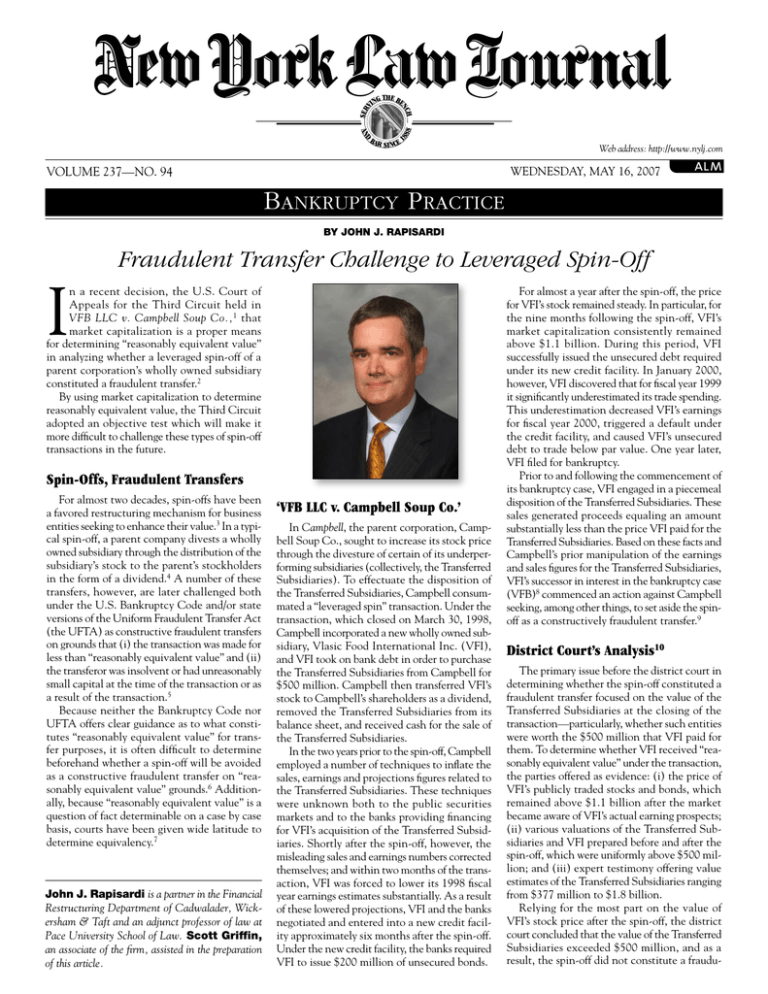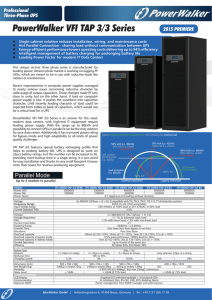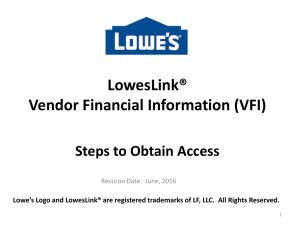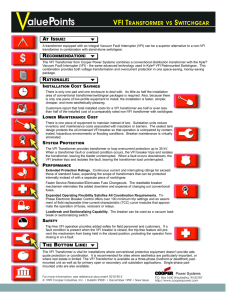
AND
88
8
SER
V
H
NC
THE BE
ING
1
BA
R SINCE
Volume 237—no. 94
Web address: http://www.nylj.com
wednesday, may 16, 2007
Bankruptcy Practice
By John J. Rapisardi
I
Fraudulent Transfer Challenge to Leveraged Spin-Off
n a recent decision, the U.S. Court of
Appeals for the Third Circuit held in
VFB LLC v. Campbell Soup Co., 1 that
market capitalization is a proper means
for determining “reasonably equivalent value”
in analyzing whether a leveraged spin-off of a
parent corporation’s wholly owned subsidiary
constituted a fraudulent transfer.2
By using market capitalization to determine
reasonably equivalent value, the Third Circuit
adopted an objective test which will make it
more difficult to challenge these types of spin-off
transactions in the future.
Spin-Offs, Fraudulent Transfers
For almost two decades, spin-offs have been
a favored restructuring mechanism for business
entities seeking to enhance their value.3 In a typical spin-off, a parent company divests a wholly
owned subsidiary through the distribution of the
subsidiary’s stock to the parent’s stockholders
in the form of a dividend.4 A number of these
transfers, however, are later challenged both
under the U.S. Bankruptcy Code and/or state
versions of the Uniform Fraudulent Transfer Act
(the UFTA) as constructive fraudulent transfers
on grounds that (i) the transaction was made for
less than “reasonably equivalent value” and (ii)
the transferor was insolvent or had unreasonably
small capital at the time of the transaction or as
a result of the transaction.5
Because neither the Bankruptcy Code nor
UFTA offers clear guidance as to what constitutes “reasonably equivalent value” for transfer purposes, it is often difficult to determine
beforehand whether a spin-off will be avoided
as a constructive fraudulent transfer on “reasonably equivalent value” grounds.6 Additionally, because “reasonably equivalent value” is a
question of fact determinable on a case by case
basis, courts have been given wide latitude to
determine equivalency.7
John J. Rapisardi is a partner in the Financial
Restructuring Department of Cadwalader, Wickersham & Taft and an adjunct professor of law at
Pace University School of Law. Scott Griffin,
an associate of the firm, assisted in the preparation
of this article.
‘VFB LLC v. Campbell Soup Co.’
In Campbell, the parent corporation, Campbell Soup Co., sought to increase its stock price
through the divesture of certain of its underperforming subsidiaries (collectively, the Transferred
Subsidiaries). To effectuate the disposition of
the Transferred Subsidiaries, Campbell consummated a “leveraged spin” transaction. Under the
transaction, which closed on March 30, 1998,
Campbell incorporated a new wholly owned subsidiary, Vlasic Food International Inc. (VFI),
and VFI took on bank debt in order to purchase
the Transferred Subsidiaries from Campbell for
$500 million. Campbell then transferred VFI’s
stock to Campbell’s shareholders as a dividend,
removed the Transferred Subsidiaries from its
balance sheet, and received cash for the sale of
the Transferred Subsidiaries.
In the two years prior to the spin-off, Campbell
employed a number of techniques to inflate the
sales, earnings and projections figures related to
the Transferred Subsidiaries. These techniques
were unknown both to the public securities
markets and to the banks providing financing
for VFI’s acquisition of the Transferred Subsidiaries. Shortly after the spin-off, however, the
misleading sales and earnings numbers corrected
themselves; and within two months of the transaction, VFI was forced to lower its 1998 fiscal
year earnings estimates substantially. As a result
of these lowered projections, VFI and the banks
negotiated and entered into a new credit facility approximately six months after the spin-off.
Under the new credit facility, the banks required
VFI to issue $200 million of unsecured bonds.
For almost a year after the spin-off, the price
for VFI’s stock remained steady. In particular, for
the nine months following the spin-off, VFI’s
market capitalization consistently remained
above $1.1 billion. During this period, VFI
successfully issued the unsecured debt required
under its new credit facility. In January 2000,
however, VFI discovered that for fiscal year 1999
it significantly underestimated its trade spending.
This underestimation decreased VFI’s earnings
for fiscal year 2000, triggered a default under
the credit facility, and caused VFI’s unsecured
debt to trade below par value. One year later,
VFI filed for bankruptcy.
Prior to and following the commencement of
its bankruptcy case, VFI engaged in a piecemeal
disposition of the Transferred Subsidiaries. These
sales generated proceeds equaling an amount
substantially less than the price VFI paid for the
Transferred Subsidiaries. Based on these facts and
Campbell’s prior manipulation of the earnings
and sales figures for the Transferred Subsidiaries,
VFI’s successor in interest in the bankruptcy case
(VFB)8 commenced an action against Campbell
seeking, among other things, to set aside the spinoff as a constructively fraudulent transfer.9
District Court’s Analysis10
The primary issue before the district court in
determining whether the spin-off constituted a
fraudulent transfer focused on the value of the
Transferred Subsidiaries at the closing of the
transaction—particularly, whether such entities
were worth the $500 million that VFI paid for
them. To determine whether VFI received “reasonably equivalent value” under the transaction,
the parties offered as evidence: (i) the price of
VFI’s publicly traded stocks and bonds, which
remained above $1.1 billion after the market
became aware of VFI’s actual earning prospects;
(ii) various valuations of the Transferred Subsidiaries and VFI prepared before and after the
spin-off, which were uniformly above $500 million; and (iii) expert testimony offering value
estimates of the Transferred Subsidiaries ranging
from $377 million to $1.8 billion.
Relying for the most part on the value of
VFI’s stock price after the spin-off, the district
court concluded that the value of the Transferred
Subsidiaries exceeded $500 million, and as a
result, the spin-off did not constitute a fraudu-
New York Law Journal
lent transfer. The district court found that the
market price was a reasonable valuation of VFI
in light of all of the information available to
market participants. The district court explained
that although VFI’s stock price was affected by
Campbell’s manipulations, it did not decline after
accurate projections of VFI were known by the
market. Thus, the district court found that VFI’s
market capitalization several months after the
transaction represented the proper value of VFI as
of the date of the spin-off. Based on the market’s
value of VFI, the district court found that the
Transferred Subsidiaries constituted reasonably
equivalent value under the transaction, and as
a result, refused to set aside the spin-off as a
fraudulent transfer.
Third Circuit’s Analysis
The Third Circuit stated that for VFB to
succeed on its appeal to set aside the spin-off
as a fraudulent transfer it had to “show that on
March 30, 1998, the [Transferred Subsidiaries
were] clearly worth less than $500 million.”11
In that regard, the Third Circuit reviewed New
Jersey’s version of the UFTA, made applicable
to VFI’s bankruptcy case by §544(b)(1) of the
Bankruptcy Code.12 The court noted that under
New Jersey law, the spin-off was avoidable if VFB
could show that (i) the transaction was made for
less than reasonably equivalent value and (ii) VFI
was insolvent or had unreasonably small capital
at the time of the transaction or as a result of the
transaction. The Third Circuit concluded that
based on VFI’s market capitalization after the
spin-off, VFB could not carry its burden.
In affirming the district court decision, the
Third Circuit found that, notwithstanding
Campbell’s manipulation of the Transferred
Subsidiaries’ sales and earnings figures prior
to the spin-off, VFI’s market capitalization
constituted a proper measure of its value. In
reaching its holding, the court dismissed VFB’s
contention that market capitalization was an
inappropriate method for determining reasonably equivalent value, as a result of the market’s
reliance on projections of future income that may
ultimately be inaccurate. The court found that
“[the market] allows participants to voluntarily
take on and transfer risk that their projections
may later be inaccurate [and that] fraudulent
transfer law cannot be utilized to undermine
[such] function.”13 Further, the court noted that
market capitalization is a proper mechanism for
valuing a business because it reflects all publicly
available information at the time of valuation,
and that “[a] company’s actual subsequent performance is something to consider when determining ex post the reasonableness of a valuation…but it is not by definition, the basis of a
substitute benchmark.”14
The Third Circuit also affirmed the district
court’s use of market capitalization in valuing
VFI, even after considering Campbell’s manipulation of the sales and earnings figures of the
Transferred Subsidiaries prior to the spin-off.
Specifically, the court found that the district
court’s reliance on VFI’s market capitalization was
appropriate because it focused on a valuation of
wednesday, may 16, 2007
VFI several months after the spin—when public
equity and debt markets had an accurate picture
of VFI’s true financial situation—as opposed to
at the time of the transaction. The Third Circuit
rejected VFB’s expert’s valuations, which focused
on post spin-off performance by “discounted cash
flow analysis.”15 Particularly, the court noted that
valuation techniques such as discounted cash
flow analysis are “inapt tools” for determining
the value of a publicly traded entity.16 The court
observed that “[a]bsent some reason to distrust
it, the market price is ‘a more reliable measure
of the stock’s value than the subjective estimates
of one or two expert witnesses.’”17
The court noted that neither VFB nor Campbell disputed that VFI’s value had not increased
at any time after the transaction. Thus, the court
found that because VFI’s market capitalization
was at least $500 million several months after the
transaction (at the time when it was no longer
affected by Campbell’s earlier manipulations),
its value at the time of the spin-off had to be
worth more than $500 million. Using similar
reasoning, the court also noted that because the
market valued VFI as solvent in fiscal year 1999,
this was strong evidence that it was solvent in
fiscal year 1998 and that VFI received reasonably
equivalent value for the consideration it paid for
the Transferred Subsidiaries.
Finally, the Third Circuit found that VFB’s
experts failed to provide specific detail as to how
Campbell’s manipulation of the Transferred Subsidiaries affected the market capitalization as of
March 30, 1998. The court noted that “[VFB’s]
approach is simply to note that Campbell played
with its operations and suggest that the market
capitalization numbers may have been wrong to
some undetermined degree.”
Case Analysis
The Third Circuit’s decision in Campbell is
significant because of the court’s reliance on
an objective market-based test for determining
whether VFI received reasonably equivalent
value in exchange for the assets purchased in
connection with the spin-off, as opposed to subjective expert determinations of what constitutes
reasonably equivalent value.
As the court noted, the market capitalization
approach is highly efficient in that it reflects the
true value of a company as determined by the
market and not by other subjective considerations. Under the facts of Campbell, the court’s
use of the market capitalization approach was
clearly appropriate because the stock of VFI was
freely traded on the New York Stock Exchange
and therefore readily susceptible to valuation
by the market.
Additionally, the court’s valuation of VFI
several months after the spin-off rather than at
the time of the transaction was also appropriate in light of the fact that the value of VFI did
not increase after the transaction and the market’s continued valuation of VFI at an amount
considerably greater than the price VFI paid
Campbell for the Transferred Subsidiaries—
despite the market’s knowledge of VFI’s true
financial projections.
The Third Circuit’s decision in Campbell
signals that it will be difficult for creditors to
unwind leveraged spin-offs without establishing
either that (i) at the time of the transfer in question, the market viewed the value received by a
transferring party under the transaction as clearly
insufficient, or (ii) the parties involved in the
transaction engaged in actual fraud. Moreover,
the decision also signals an attempt by the Third
Circuit to curtail litigation relating to spin-offs
based on a party’s dissatisfaction with the financial results of the transaction.
Conclusion
The Third Circuit’s ruling in Campbell should
provide useful insight as to what constitutes
reasonably equivalent value for publicly traded
entities planning and structuring the spin-off
of a subsidiary. Based on the court’s ruling, it
would be prudent for publicly traded companies
seeking to transfer assets in a spin-off to first
determine the market value for the assets to be
transferred prior to consummating the contemplated transaction.
•••••••••••••
••••••••••••••••
1. VFB LLC v. Campbell Soup Co., No. 05-4879, 2007
WL 942360 (3d Cir. March 30, 2007).
2. In addition to its holding regarding the use of market
capitalization to determine reasonably equivalent value, the
court also held in Campbell that directors of a solvent wholly
owned subsidiary owe no fiduciary duty of loyalty to the subsidiary as against the parent company. The court, however,
pointed out that if the subsidiary included a minority interest in addition to the parent’s interest or was insolvent, the
subsidiary’s directors also serving as employees of the parent
would have divided loyalties, which would subject the spinoff to a heightened level of scrutiny.
3. See Richard M. Cieri et al., “Breaking Up Is Hard
to Do: Avoiding the Solvency-Related Pitfalls in Spinoff
Transactions,” 54 Bus. Law. 533, 534 & n.12 (1999) (citing
to a 1995 study illustrating the benefits of equity reorganizations, such as spin-offs).
4. See id.; see also Bruce N. Hawthorne et al., “Planning
and Structuring Spin-Offs and Subsidiary Offerings,” 1279
PLI/Corp 185, 188 (PLI 2001).
5. See 11 USC §§544(b)(1), 548(a)(1); Unif. Fraudulent
Transfer Act, 7A U.L.A. 639 (1985); see also Unif. Fraudulent Conveyance Act, 7A U.L.A. 427 (1985). A majority of
states have adopted either the UFTA or the Uniform Fraudulent Conveyance Act, which are substantially similar. This
article’s discussion in connection with Campbell focuses on
the meaning of “reasonably equivalent value” for constructive fraudulent transfers under the UFTA and §548 of the
Bankruptcy Code.
6. See, e.g., 11 USC §548; Unif. Fraudulent Transfer Act
§§3(a), 4(a)(2).
7. See Balaber-Strauss v. Sixty-Five Brokers (In re Churchill
Mortg. Inv. Corp.), 256 BR 664, 678-79 (Bankr. S.D.N.Y.
2000), aff’d sub nom. Balaber-Strauss v. Lawrence, 264 BR
303 (SDNY 2001).
8. Under VFI’s plan of reorganization, VFB was assigned
the right to prosecute, on behalf of VFI’s creditors, any
causes of action which VFI was entitled to commence, including claims against Campbell.
9. VFB did not commence an action against Campbell
shareholders who received VFI stock.
10. VFB LLC v. Campbell Soup Co., No. Civ. A. 02-137,
2005 WL 2234606 (D. Del. Sept. 13, 2005).
11. 2007 WL 942360, at *8.
12. See N.J. Stat. Ann. §§25:2-25(b), 25:2-27(a) (West
1997 & Supp. 2007).
13. 2007 WL 942360, at *6.
14. Id. (citation omitted).
15. Id. at *8.
16. Id.
17. Id. (citation omitted).
Reprinted with permission from the May 16, 2007 edition of the New York Law Journal. © 2007 ALM
Properties, Inc. All rights reserved. Further duplication
without permission is prohibited. For information,
contact 212.545.6111 or visit www.almreprints.com.
#070-05-07-0028






